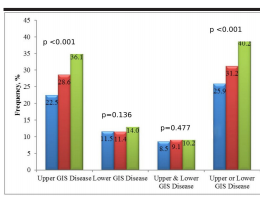Background/Aims: The aim of this study was to determine the prevalence of symptoms and diseases of the lower and upper gastrointestinal system (GIS) in a population-based sample.
Materials and Methods: The cross-sectional cohort study was conducted in Cappadocia cohort comprising the Gülşehir and Avanos districts. The “Gastrointestinal Symptom Questionnaire” was applied to persons over the age of 18 years.
Results: The GI Symptom Questionnaire was applied to 3369 subjects, and height and body weight were measured in 2797 consenting subjects. Of the participants, 61% were female and the mean patient age was 50±15 years. At least one GI symptom was present in 70.6% of the cohort. The most common upper GI symptoms were gastric bloating (31.0%) and heartburn (29.1%). The most common lower GI symptom was abnormal defecation (33.5). The prevalence of upper GIS and lower GIS diseases was 32.7% and 12.9%, respectively, and the prevalence of togetherness of upper and lower GIS diseases was 9.9%. Prevalence of GIS disease was approximately 3 times higher in females (p<0.001). All of the upper and lower GI symptoms and the prevalence of upper GIS disease increased in line with Body mass index (BMI).
Conclusion: This first population-based, cross-sectional cohort study revealed that the prevalence of GIS diseases is critically high for optimal public health. Special attention must be paid to these diseases while planning health policies and reimbursements.
Cite this article as: Sezgin O, Akpınar H, Özer B, Törüner M, Bal K, Bor S. Population-based assessment of gastrointestinal symptoms and diseases: Cappadocia Cohort, Turkey. Turk J Gastroenterol 2019; 30(12): 1009-20.




.png)
.png)
